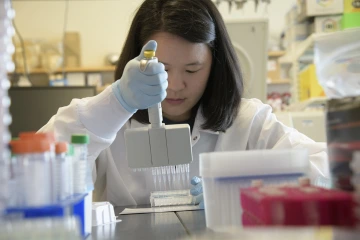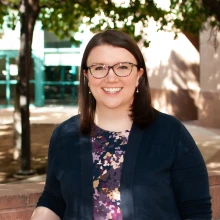COVID-19 Partnerships Drive Record Year of Research Funding
Health Sciences researchers have broken an institutional funding record as they tackle a range of challenging health problems, now including COVID-19.

Since 2013, Health Sciences research funding has been on a steady upward trajectory, more than doubling annual earnings in that time.
The University of Arizona Health Sciences closed out the 2019-20 fiscal year, which ended June 30, with a total of $208,590,904 in research funding awards, marking the first time Health Sciences has broken the $200 million barrier and setting a new record.

Lauren Zajac, MPA
“We really knocked it out of the park last year,” Zajac recalled, adding that they came within a hair’s breadth of $200 million and hoped to pass that milestone this year. But, when research funding appeared to be slowing down, her group wasn’t sure it would happen.
Then came COVID-19.
“Be careful what you wish for,” Zajac said. “When COVID hit, it lit the fire and encouraged many of our researchers to respond to the challenge.”
COVID-19 spurs new research funding opportunities
In March, demand for COVID-related research surged, opening the door to myriad grant opportunities. Research Administration jumped into overdrive, working with Health Sciences researchers to apply for – and win – a record number of grants.

Rachel Wong, Department of Immunobiology research specialist and graduate student, validates the antibody test, which Research Administration ushered from the lab to the community.
“We surpassed last year, which was so surprising,” Zajac said. “The entire campus really responded to the new opportunities, pulling together quick teams to compete. That’s what pushed us over the goal line.”
The burst in coronavirus-related research included efforts such as the antibody test developed by the College of Medicine – Tucson’s Janko Nikolich-Žugich, MD, PhD, and Deepta Bhattacharya, PhD. Zajac’s office was an integral behind-the-scenes force in bringing this testing to Arizona and the campus community. Without her meticulous and nimble team, the test wouldn’t have gone from the laboratory to the community in just a matter of weeks.
“We were excited to be able to respond so quickly,” Zajac said. “COVID-19 was moving fast, and we had to be fast to respond to it.”
Beyond COVID-19
The Research Administration Office, led by Zajac and her leadership team, including Christine Gaul, MBA, Elisha Johnson, JD, and Shannon Carver, allows Health Sciences researchers to focus on the science of their grant application rather than the administrative details. Sairam Parthasarathy, MD, chief of the Division of Pulmonary, Allergy, Critical Care and Sleep Medicine at the College of Medicine – Tucson, likened Zajac’s team to the launchpad for a rocket. No matter how advanced and sophisticated the rocket, he said, it’s not going to get off the ground without the proper foundation.

Sairam Parthasarathy, MD, is founding director of the Center for Sleep and Circadian Sciences. Research Administration was integral in securing funding to move their sleep research lab from above a bar on Speedway to a quieter campus location. (Photo: Kris Hanning)
“Without help from the pre-awards group, these large complex grants are infeasible to deliver in time,” Dr. Parthasarathy said. “There are so many moving parts that, if I’m focusing on all of that, I won’t be able to write a good grant.”
Dr. Parthasarathy collaborated with other sleep researchers for a rare NIH construction grant for $5 million awarded this past year to Michael D. Dake, MD, senior vice president for Health Sciences, to build a new home for the Center for Sleep and Circadian Sciences.
“The construction program is a rare opportunity that NIH offers every so often, which enables you to pull together a physical space for researchers who have NIH funding,” Zajac said.
The construction grant will be a game changer for the center, which currently conducts sleep studies in a rented space above a popular bar on Speedway Boulevard.
“You’d have to struggle to find a less ideal location for a sleep research center,” Zajac joked.
Making research support accessible
Zajac is a veteran of her field, having spent more than two decades working closely with academic researchers. In 2014, she joined Health Sciences as the founding director of the Research Administration Office, which coordinates grant submissions, contracting, clinical trials and regulatory support. In just six years, Zajac has built a team of 42 people who support researchers across the Health Sciences campuses.

Leslie Farland, ScD, says the support she receives from Research Administration allows her to “focus on the science.”
Research Administration provides valuable resources for all researchers – especially for scientists early in their careers who might not have the capacity to do the work effectively themselves. Leslie Farland, ScD, assistant professor in the Department of Epidemiology and Biostatistics at the Mel and Enid Zuckerman College of Public Health, arrived at Health Sciences in 2018 and has had many successful collaborations with Zajac’s office.
“I have a colleague who is at another institution. It’s night and day between the amount of research support we both receive,” Dr. Farland noted.
Dr. Farland researches reproductive and gynecologic health with an emphasis on endometriosis, a condition associated with infertility and other poor health outcomes. Supported by Research Administration, Dr. Farland has won hundreds of thousands of dollars in funding for women’s health research this past fiscal year and received her first NIH grant to study the relationship between endometriosis, infertility and stroke.
“They do such a detailed job, always with a smile on their face,” Dr. Farland said. “They make sure we’re dotting our i’s and crossing our t’s, so that we can focus on the science. I really appreciate all that they do.”
The pandemic brings all hands on deck
Zajac encourages researchers to “apply and apply often,” and faculty have taken that maxim seriously, leading to a large increase in submissions compared to the previous fiscal year. With more funding, however, comes more work.
“This has been fast and furious, but we don’t shy from the challenge.”Lauren Zajac, MPA
“I have felt like we are in a constant state of perpetual motion, submitting grants and initiating a number of clinical trials since the pandemic hit. We submit something every day,” Zajac said. “This has been fast and furious, but we don’t shy from the challenge.”
Despite extended workdays and sacrificed weekends, Zajac finds deep satisfaction in the work her team has done to bring COVID-19 testing to the community.
“It’s an all-hands-on-deck mentality,” Zajac said. “I love motivating my team, and trying to keep people as positive as possible. You have to have that intrinsic feeling that you’re contributing. It feels really good to do something to give back.”

